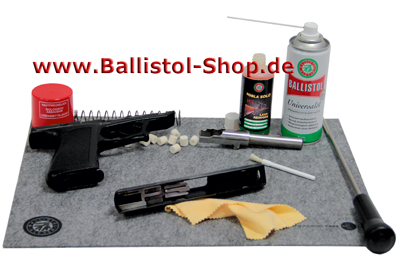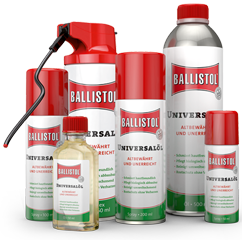Ballistol Gun Care Guide
If the gun became wet while being used, it must be dried by means of a soft cotton cloth on the outside without exerting pressure. Then spray Ballistol into the barrel on both ends, shake and turn the barrel several times so that all the lands and rifling, the whole of the polygon surface are reached by Ballistol. Then allow Ballistol to react for a couple of minutes so that remnants of grease and deflagration can be dissolved. Mind that the muzzle must point downward while you are cleaning your gun, otherwise powder fouling, unburnt propelling charge or other kinds of dirt might get into the system and settle there. The system might lose its smoothness and it might even happen that the firing pin gets seized.
Why gun care is important
 Propelling charges also hit back into the system during ignition. Gun-smoke and tiny particles get into the movable parts and deposit there. Therefore these areas must be cleaned especially diligently with Ballistol. Cotton-wool tips and pipe cleaners will help you with that. Surplus Ballistol can easily be removed with a soft cotton cloth. What is important is that a thin film of Ballistol remains. After that pull a dry tow or felt-stopper from the cartridge chamber to the muzzle in case it is a break-joint gun or, if there is no joint, from the muzzle to the cartridge chamber and back. Always use a new tow or felt-stopper because dirt is to be removed and not to be distributed evenly. Then wipe the Ballistol-moist outside of the gun again slightly. Every now and then the rifle-sling ought to be treated with Ballistol, too, so that is does not become hard or go mouldy but stays supple and smooth.
Propelling charges also hit back into the system during ignition. Gun-smoke and tiny particles get into the movable parts and deposit there. Therefore these areas must be cleaned especially diligently with Ballistol. Cotton-wool tips and pipe cleaners will help you with that. Surplus Ballistol can easily be removed with a soft cotton cloth. What is important is that a thin film of Ballistol remains. After that pull a dry tow or felt-stopper from the cartridge chamber to the muzzle in case it is a break-joint gun or, if there is no joint, from the muzzle to the cartridge chamber and back. Always use a new tow or felt-stopper because dirt is to be removed and not to be distributed evenly. Then wipe the Ballistol-moist outside of the gun again slightly. Every now and then the rifle-sling ought to be treated with Ballistol, too, so that is does not become hard or go mouldy but stays supple and smooth.
Pistol magazines, too, must be cleaned regularly with Ballistol, because there are also traces of gun powder and the cartridge feed in the magazine must remain smooth.
Gun Care - how you proceed
Try to avoid cleaning chains or, if that is unavoidable, don't forget to use some kind of muzzle protection. Like little strokes fell big oaks, chain-links will remove layer after layer in the muzzle area until shot precision is affected drastically. Particularly the use of wire brushes cases muzzle damage when you frequently scrub back and forth with the cleaning rod instead of removing the brush after pushing through the rod in one direction. In case of metal residue in the gun it would be best not to use any wire brushes and such harsh techniques but use Robla-Solo. Below you will find more about that. Your gun is now ready for service again or prepared for storage. If you do not use your gun for a longer period of time, it would be wise to oil the barrel. Just pull a tow moistened with Ballistol through it and the remaining film of Ballistol protects safely against corrosion under normal circumstances.
After a strenuous hunt you are often reluctant to clean the gun right away. In that case just spray some Ballistol into the barrel on both ends and a little touch on the outside of the gun and you can postpone cleaning to the following day without causing any damage to your gun. Don't forget: the muzzle is to point downward as we have already mentioned above. Only the completely cleaned gun can be stored with the muzzle pointing upward in the gun cabinet.
By the way you can also unse Gunex to improve the outward appearance of your gun. Gunex protects against corrosion even better and longer than Ballistol does. That is why Gunex should be used above all when weather conditions are bad and when the gun cannot be cleaned for days. For cleaning your gun inside however, only use Ballistol, for only alkaline gun oil like Ballistol can neutralize acid residue efficiently and thus avoid damage. Besides, under normal circumstances Ballistol protects sufficiently against corrosion in the field of hunting and shooting.
Please remember, real browning are oxide coats that are ultrathin. Like a coat of paint for example, they also suffer from mechanical wear and tear if not treated gently. Intense rubbing can eliminate the browning quickly. Therefore you should treat the browned parts almost tenderly with a soft cloth so that you can enjoy the gloss of the deeply black browning for a long time. Should the browning be damaged anyway, you can do the repair work yourself by means of Klever Quick-Browning. More about you will find below. With some sub-caliber rifles (e.g. Remington) some parts of the gun consist of aluminium-base alloys or similar materials. Such parts cannot be browned. Consequently, those parts are varnished black with a dull finish, which comes close to the impression a real browning makes. In many cases the varnish is not oil-resistant. In that case it suffices if you clean those parts with a wet cloth. Barrel and lock however are always made of steel, which means they should always be cleaned with Ballistol.
Sometimes certain people recommend employing gun-oils containing PTFE. We strictly object to and warn against that recommendation if those products are used in the barrel or the cartridge chamber. Those most finely distributed polymers contain carbon fluorides. During ignition there are temperatures of up to 3000° Centigrade and an immense pressure increase (2000-3000 bar) in the cartridge chamber and in the barrel. Under such conditions the fluoride containing polymers decompose, and small amounts of hydro-fluoric acid come into being. Hydro-fluoric acid is highly aggressive and often causes pitting in the barrel. So, be utterly careful when you use products containing PTFE. These products should only be used with the mechanical parts, but even there they don't have any advantages.
If you use full-jacketed or partly jacketed cartridges and if your ammunition expenditures are average, gun maintenance with Ballistol or Gunex will be absolutely sufficient. At least once a year or, if you shoot frequently, more often than just once, you should thoroughly clean your whole gun.
Residues in the barrel caused by lead and tombac bullets
Some barrels become inaccurate after only 10 shots, others after 50 shots. Why? The tombac alloy of the modern deformation projectiles gives off tiny parts and covers the metal surface in the barrel with a thin layer of metal residue, which becomes thicker with every shot until even the best gun spreads the shots' for no obvious reasons.
Employed correctly, Robla-Solo Mil is the safest and most gentle method of regaining the gun's precision if metal residue is the reason why the gun has become inaccurate. Robla-Solo is far better than any wire-brushes and other similar instruments of torture. Finally Robla-Solo replaces steel wool, which has ruined so many barrels irrevocably after just one cleaning. Robla-Solo gently dissolves tombac, copper, lead and zinc without damaging steel, nickel and chrome.
Usage of Robla Solo: In case of strong metal residue plug the barrel on one end with a cork or piece of gum and fill the barrel with Robla-Solo. Allow for a couple of hours to let Robla-Solo do its job. If the barrel is only slightly foul, simply pull through a tow or cleaning felt stopper wetted with Robla-Solo, that will do then. A yellow to blue colour indicates dissolved copper and tombac, whereas zinc and lead leave a colourless solution. Repeat this procedure until the felt respectively tow remains uncoloured. Let the solution run off, then pull a dry tow through the barrel and after that use Ballistol Gun Oil or Gunex Gun Oil. Before you use the gun then, we advise you to pull a dry tow through the barrel again.
Don't let the barrel lie around for a longer period of time when it is only moist with Robla-Solo, because then the ammoniac compounds will evaporate and the remaining water may react with certain organic salts thus causing localized corrosion. The dissolving power of Robla-Solo is so enormous that it can even corrode the browning. Browned parts that have been moistened with Robla-Solo must be dabbed at once or rinsed with water. If necessary, repairs can be carried out with Klever-Quick-Browning, which will be described below.
By the way, be careful when you clean hard chromed barrels with Robla-Solo (this is also relevant to other comparable products). The chrome-plating is often coated on copper that has been disengaged by means of an electrolytic process which is advantageous compared to the process of direct chrome-plating of the barrel steel. If the coat of chrome has any fissures, even if they are only of microscopic size, the barrel cleaner will corrode the underlying layer of copper, which is its task when there is metal residue in the barrel. The consequence is that the copper under the chrome will be dissolved and then the chrome will come off eventually, too. Mind you, this will not happen if the coat of hardened chrome is absolutely flawless.
Damaged Browning
The browning of a gun can be damaged by too intensive a cleaning, during a rough hunt or, when a riflescope is fitted. To spare you the trouble of complicated decoction and an expensive new browning in the browning bath, you can repair minor damages by means of Klever Quick-Browning. Klever-Quick-Browning plus treatment with Ballistol or Gunex 2000 bring about a deeply black dull finish quickly. This coating is wear-resistant and oil-proof. With a little skill you can achieve the same results as with on original browning. If you are a little more experienced you can brown even complete barrels with Klever-Quick-Browning, or single parts such as screws, nuts and bolts. Please remember that steel containing more than four percent of chrome cannot be browned. The same is relevant to casings made of aluminium or zinc. There are other special products for these metals.
Usage of browning liquid: The part to be browned must be totally free from grease in order to achieve an even browning. We recommend Robla-Cold-Degreaser for this purpose. Put the degreaser with a brush on the part you want to brown and then wipe it off again. Repeat this several times but don't wipe off the degreaser finally, just let it run off slantingly. When the part is dry again, take another brush and put Klever-Quick-Browning on it. After one to two minutes there will be a yellow coat. Now you can rinse the treated part with plenty of water. Then dab the repaired spot with a paper- handkerchief. At last use Ballistol or Gunex spray and remove surplus oil with a cotton cloth. The new browning will then appear deeply black.
Caution: Klever-quick-Browning contains a mineral acid. Like all mineral acids it is caustic. Therefor take care when working. If the acid gets on your skin, mucous membranes or into your eyes, immediately rinse out with water or see a doctor. Mark you that Klever-Quick-Browning does not get under your fingernails, otherwise the thin cuticle might get cauterized. There are always lots of bacteria in the nail-bed which can cause painful onychitis. The best thing you can do to protect your hands is to use thick rubber gloves.
How to preserve stocks
Most stocks are so-called oil-stocks, i.e. the wood has already been impregnated by the manufacturer. Furthermore there are burnished stocks, mainly with English rifles and the weapons of connoisseurs. Whatever the style of the stock of your gun be, with our series of Balsin and Schaftol products you have superb polishes available.
Our Gun Stock-Oils provides even old, brittle and weather-beaten wooden stocks with a new silky lustre. Balsin and Schaftol Stock-Oils makes the wood water-repellent, protects it against decay and mould, enhances its veining, and increases its power of resistance against the impacts of weather. Thus the stock is kept smooth and stain-free. Ballistol Stock-Oils are absolutely ideal for the preventive maintenance of walnut-stocks and other unprocessed wooden materials. It is also highly recommendable for furniture without varnish.
Our Stock-Oil comes in various colours for each wood. The latter two will help you especially with the treatment of natural wood to achieve the desired tinge as well as with recoloring wood. For intensifying the graining of the wood and for the regular maintenance after hunting-sessions we recommend Balsin-Stock-Oil bright.
Usage of Stock-Oils: First the stock is to be abraded with corundum paper (corn 280) till the surface is free from uneven spots. Then the stock is rubbed down again with fine corundum (corn 400) so that you will get a smooth surface. After that you rub the wood with a lint-free cotton cloth. If the stock is indented or if parts of the wood are splintered off, these damages are to be treated with a file beforehand to make the surface evenly smooth. This measure is of course redundant in case the stock is already smooth and is just to be repolished.
The dust- and fluff-free stock can now be coated evenly with Stock-Oil. This may be done either with a brush or a cloth that has been dipped in Stock-Oil or just let the oil drop on the stock and then rub and distribute it on the surface. How often you will repeat this procedure depends on the shade you want to achieve. After the final coating, rub the wood with a lint-free soft cotton cloth. Form the cloth into a ball and move it in small circles to reach all the pores of the wood in like manner. If you do not have a lint-free cloth at hand you can carry out the final treatment with the ball of your thumb. The stock has now got a marvellous silky gloss and is protected against rain, moisture, decay and mould for a long period of time.
Muzzle loaders, Blank Guns and Signal Weapons
For the removal and treatment of remainders of black powder, e.g. in muzzle loaders, blank guns and signal weapons, Ballistol-Klever has developed a special product for you: Robla-Blackpowder-Solvent.
Contrarious to the propelling charge of modern ammunition which hardly produces any smoke, remainders out of the deflagration of black powder consist of anorganic salts, soot and other products of combustion. These remnants endorse the destructive forces of corrosion in the barrel much more than the remnants of modern propelling charges do. Gun oils which are all of organic nature cannot eliminate those remnants satisfactorily. That is why you need Robla-Blackpowder-Solvent, which masters that problem in an outstanding way.
Usage of Black Powder Solvent: Saturate the tow or felt stopper attached to your cleaning-rod, or the brush your purchased together with you blank gun with Robla-Blackpowder-Solvent. Then pull the tow, etc. several times through the barrel that is to be cleaned. How often you repeat this procedure is dependent on how much residue has accumulated in the barrel. Analogously the revolving breeches in blank guns must be treated. Then the treated parts need to be dried by pulling through a new tow for instance, and finally. Ballistol should be applied as described ahead. It is advisable to repeat this procedure several times to achieve optimal results.
Caution: Robla-Backpowder-Solvent can damage the browning of your gun. So try to avoid squirts on the browning. Should it happen that some solvent gets onto the browning, it must be dabbed immediately, and the afflicted spot must be rinsed with water. Never let your gun lie around for a longer period of time after it has been treated with Robla-Blackpowder-Solvent. Subsequent to that your gun ought to get an after-treatment with Ballistol. If the solvent gets into your eyes, rinse with water at once. If the solvent gets in contact with your skin, it is enough to simply wipe it off.
Some Hints for how to Store Guns
Apart from all the security instruction, which is certainly well-known to you, there are some additional aspects which might be of interest to you, too. Always keep your gun stored in a dry place. Usually, these conditions are fulfilled in a gun cabinet at normal room temperature and average humidity. In spite of this - though very rarely - your gun might be afflicted by corrosion, even if the maintenance of the gun has been perfect. Do not put the blame on the gun oil you used, particularly when you used Ballistol or Gunex Rather look for other reasons that might have caused corrosion. For example, if you have stored your ammunition close to the gun. Every cartridge emits gases, although in tiny quantities that are hardly traceable. In principle this is not surprising because propelling charges consist of very labile compounds, which are bound to burn themselves due to their structure. This burning process comes to pass extremely fast in case of an ignition, but at room temperature, too, there is a tiny bit of conversion. That is why the storage of cartridges is limited. It depends on both the quality and quantity of the Ammunition stored, if the escaped gases in connection with the humidity in the air will cause any corrosion. It must also be taken into consideration that in a cabinet there is virtually no exchange of air so that an accumulation of noxious gases is easily possible. Therefore you should keep your ammunition separated from your gun, if possible in an extra partition and always with a dehumidifier in the gun locker and in the ammunition locker. To air regularly is a good prophylactic measure.
What you might want to know about Ballistol
Ballistol was developed by Dr. Helmut-Wolfgang Klever, son of the founder of the company, encouraged by the German Reich army. What was needed was a kind of oil which could be used for many purposes, e.g. for weapons and wounds, and which was suitable for the soldier's field pack to have some first aid available for light wounds. Such a seemingly contradictory combination of medical and technological aspects was not unusual in those days. Just take for example Vaseline, which was then used as a lubricant, as an admixture to bandages, or in the field of cosmetics.
1904 was so to say the year of birth of Ballistol. The brand name is derived from the word "ballistics". Due to its versatility and excellent quality Ballistol became a great success. It is not exaggerated to claim that no other similar oil compares to Ballistol. The founding fathers of our firm liked experiments and so soon found new fields of application for Ballistol: from gun maintenance to the treatment of wounds, from treating certain inner diseases to mycosis pedis (athlete's foot) and psoriasis, from the crest scrag of hens to the catarrh of rabbits, from the treatment of the hunting dog's ears to saddle problems with horses, from the inflammation of the guns to behinds sore from riding. Simultaneously creative hobbyists and artisans found new and other ways of how and where to use Ballistol: instruments used in the field of mechanics and precision mechanics and all machines and engines made of iron and steel; everything that needs to be protected against corrosion and to be easily movable: from the automobile to the machinery in industries, from bicycles, locks, door-hinges, instruments for gardening, to mechanical clockworks, water meters, bottling-plants and sausage making machines. Beside protecting excellently against corrosion and lubricating, Ballistol can do many more things: it is a disinfectant, too; this is why many dentists used Ballistol for the maintenance and disinfection of their instruments before World War II. In some hospitals it is still used today in the process of steam sterilization of surgical instruments and apparatuses. There are no objections whatsoever to taking Ballistol like a medicine. Animal experiments have shown that even if the stomach of the animal was filled completely with Ballistol, there was no harm done at all, no case of poisoning. Little children are said to have drunk a whole bottle of Ballistol by mistake. There were no harmful consequences; the only thing that was reported was that the children felt a little hung-over on the following day.
After the Second World War a new law on the manufacture and prescription of medicines was passed, which made it necessary to distinguish between NEO-Ballistol, which is registered as a medicinal remedy, and Ballistol, which, according to the law, could no longer be advertised as a medicine.
Otherwise it would have had to be registered as a medicinal remedy, which means it can only be sold at the chemists. So Ballistol was developed further into NEO-Ballistol, which does no longer protect against corrosion but has an increased remedial effect through the addition of valuable natural substances.
Ballistol however, is still being produced as it has been produced since 1905 without any alterations. Four or even more generations of people have with reason relied on the invariable set of ingredients of Ballistol. The valuable natural substances used for the production of Ballistol are of outstanding purity as it must be the case with medicines and the production is under strict control. Thus, if the bottle is well screwed up, Ballistol can be stored for 25 or even more years without losing its thin liquid consistency, without gumming up or becoming ineffective. Only its colour gets a little darker after a quarter century or so. Ballistol has also got what we call an ecological plus. In contrary to other technical oils, including most gun oils, the oil contained in Ballistol does not contaminate our drinking water. Moreover, the substances used in Ballistol are part of nature, are components of the natural circulation and are so decomposed biologically. If you want to know more about the manifold forms of application of Ballistol, just order the Ballistol Story or other brochures or find more special Information under the links below.
Here you find the full range of gun Care Products.
Here you find all reports and information on Ballistol
 Can Ballistol resinify?
Can Ballistol resinify?
(only in german)
 What is medical-grade white oil?
What is medical-grade white oil?
(only in german)
 Differences in oils
Differences in oils
(only in german)
 Restore a Zippo with Ballistol
Restore a Zippo with Ballistol
(only in german)
 Corrosion and Corrosion Protection
Corrosion and Corrosion Protection
(only in german)
 Ballistol and brass
Ballistol and brass
(only in german)
 Durability of Ballistol
Durability of Ballistol
(only in german)
 Ballistol as gun oil
Ballistol as gun oil
(only in german)
 Mosquito-protection tested in Africa by riverboat doctors international
Mosquito-protection tested in Africa by riverboat doctors international
(only in german)
 Mosquitoes and ticks
Mosquitoes and ticks
(only in german)
 Agents against ticks
Agents against ticks
(only in german)
 Use of pepper spray
Use of pepper spray
(only in german)
 Use of CS defense-spray
Use of CS defense-spray
(only in german)
 Gun Care Guide
Gun Care Guide
 Bicycle care Tips
Bicycle care Tips
(only in german)
 Maintain musical instruments with Ballistol
Maintain musical instruments with Ballistol
(only in german)
 The Vaseline Story
The Vaseline Story
(only in german)
 The Ballistol Store in Meerbusch
The Ballistol Store in Meerbusch
 Packaging pollute the environment
Packaging pollute the environment
(only in german)
 Brochures, catalogues and flyer for the Ballistol products
Brochures, catalogues and flyer for the Ballistol products
 Lubricants from Ballistol
Lubricants from Ballistol
(only in german)
 All information of Ballistol at a glance
All information of Ballistol at a glance








